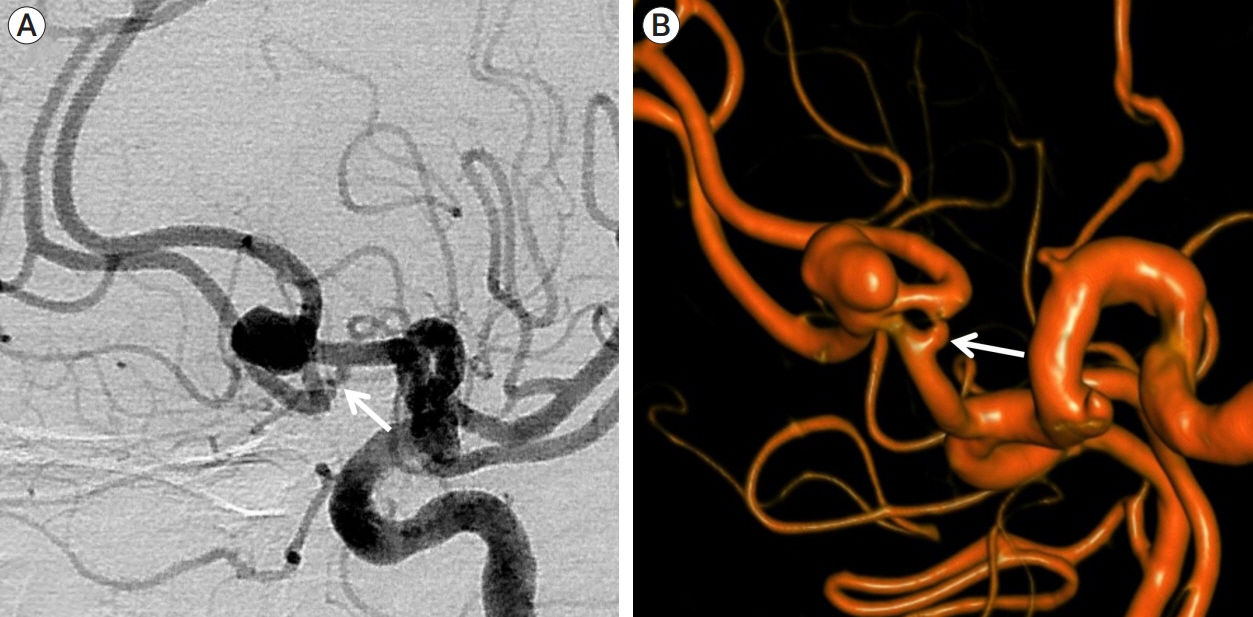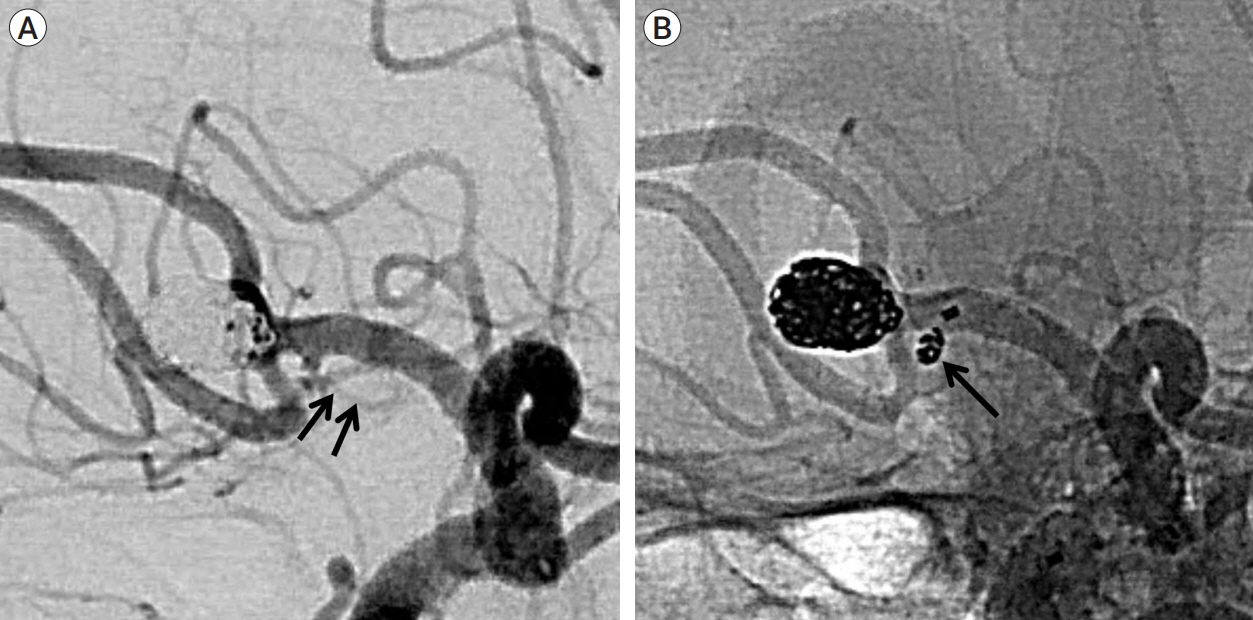J Cerebrovasc Endovasc Neurosurg.
2022 Dec;24(4):393-397. 10.7461/jcen.2022.E2021.12.001.
Wire perforation of the missed tiny aneurysm originating from the fenestrated A1 segment during the endovascular approach
- Affiliations
-
- 1Department of Neurosurgery, Medical Research Institute, Pusan National University Hospital, Busan, Korea
- KMID: 2537325
- DOI: http://doi.org/10.7461/jcen.2022.E2021.12.001
Abstract
- Vascular anomaly and aneurysmal formation of an anterior communicating artery (ACOM) complex has often been reported. Because of such a complicated relationship between the vascular structure and aneurysms, ACOM aneurysm is one of the most difficult aneurysms to treat among other common anterior circulation aneurysms. We herein report a case of wire perforation of a missed tiny aneurysm arising from the fenestrated A1 segment during the endovascular approach to ACOM aneurysm. Although the fenestration of A1 segment is a rare vascular anomaly, it is likely to accompany saccular type aneurysms in the vicinity of the vascular anomaly. Endovascular treatment for ACOM aneurysm requires more detailed evaluations of the accompanying vascular anomaly and hemodynamics around ACOM to avoid complications.
Figure
Reference
-
1. de Gast AN, van Rooij WJ, Sluzewski M. Fenestrations of the anterior communicating artery: incidence on 3D angiography and relationship to aneurysms. AJNR Am J Neuroradiol. 2008; Feb. 29(2):296–8.
Article2. Halbach VV, Higashida RT, Dowd CF, Barnwell SL, Hieshima GB. Management of vascular perforations that occur during neurointerventional procedures. AJNR Am J Neuroradiol. 1991; Mar-Apr. 12(2):319–27.3. Ihara S, Uemura K, Tsukada A, Yanaka K, Nose T. Aneurysm and fenestration of the azygos anterior cerebral artery: case report. Neurol Med Chir (Tokyo). 2003; May. 43(5):246–9.4. Iwabuchi N, Saito A, Fujimoto K, Nakamura T, Sasaki T. Unruptured saccular aneurysm arising from the fenestrated A1 segment of the anterior cerebral artery: report of 2 cases. Case Rep Neurol. 2018; Jun. 10(2):140–9.
Article5. Kachhara R, Nair S, Gupta AK. Fenestration of the proximal anterior cerebral artery (A1) with aneurysm manifesting as subarachnoid hemorrhage: case report. Neurol Med Chir (Tokyo). 1998; Jul. 38(7):409–12.
Article6. Kwon WK, Park KJ, Park DH, Kang SH. Ruptured saccular aneurysm arising from fenestrated proximal anterior cerebral artery: case report and literature review. J Korean Neurosurg Soc. 2013; May. 53(5):293–6.
Article7. Ogawa A, Suzuki M, Sakurai Y, Yoshimoto T. Vascular anomalies associated with aneurysms of the anterior communicating artery: microsurgical observations. J Neurosurg. 1990; May. 72(5):706–9.
Article8. Ryu CW, Lee CY, Koh JS, Choi SK, Kim EJ. Vascular perforation during coil embolization of an intracranial aneurysm: the incidence, mechanism, and clinical outcome. Neurointervention. 2011; Feb. 6(1):17–22.
Article
- Full Text Links
- Actions
-
Cited
- CITED
-
- Close
- Share
- Similar articles
-
- ERRATUM: Wire perforation of the missed tiny aneurysm originating from the fenestrated A1 segment during the endovascular approach
- Ruptured Saccular Aneurysm Arising from Fenestrated Proximal Anterior Cerebral Artery : Case Report and Literature Review
- Fusiform Aneurysm of Proximal Anterior Cerebral Artery: Case Report
- Endovascular Repair of Thoracic Aortic Aneurysm Using a Custom-made Fenestrated Stent Graft to Preserve the Left Subclavian Artery
- Fenestrated Endovascular Aneurysm Repair versus Snorkel Endovascular Aneurysm Repair: Competing yet Complementary Strategies






